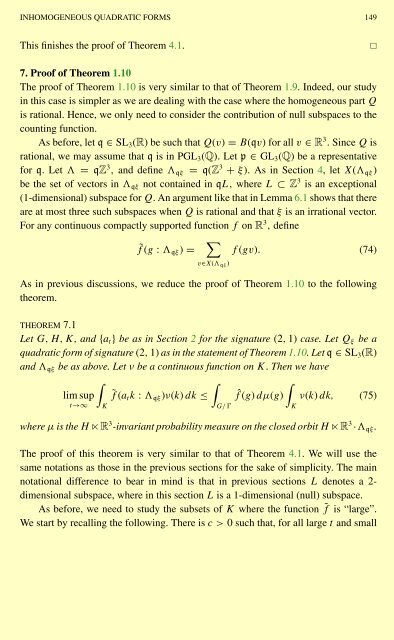NEAR OPTIMAL BOUNDS IN FREIMAN'S THEOREM
NEAR OPTIMAL BOUNDS IN FREIMAN'S THEOREM
NEAR OPTIMAL BOUNDS IN FREIMAN'S THEOREM
You also want an ePaper? Increase the reach of your titles
YUMPU automatically turns print PDFs into web optimized ePapers that Google loves.
<strong>IN</strong>HOMOGENEOUS QUADRATIC FORMS 149<br />
This finishes the proof of Theorem 4.1. <br />
7. Proof of Theorem 1.10<br />
The proof of Theorem 1.10 is very similar to that of Theorem 1.9. Indeed, our study<br />
in this case is simpler as we are dealing with the case where the homogeneous part Q<br />
is rational. Hence, we only need to consider the contribution of null subspaces to the<br />
counting function.<br />
As before, let q ∈ SL3(R) be such that Q(v) = B(qv) for all v ∈ R 3 . Since Q is<br />
rational, we may assume that q is in PGL3(Q). Let p ∈ GL3(Q) be a representative<br />
for q. Let = qZ 3 , and define qξ = q(Z 3 + ξ). As in Section 4, letX(qξ)<br />
be the set of vectors in qξ not contained in qL, where L ⊂ Z 3 is an exceptional<br />
(1-dimensional) subspace for Q. An argument like that in Lemma 6.1 shows that there<br />
are at most three such subspaces when Q is rational and that ξ is an irrational vector.<br />
For any continuous compactly supported function f on R 3 , define<br />
f ˜(g<br />
: qξ) = <br />
v∈X(qξ )<br />
f (gv). (74)<br />
As in previous discussions, we reduce the proof of Theorem 1.10 to the following<br />
theorem.<br />
<strong>THEOREM</strong> 7.1<br />
Let G, H, K, and {at} be as in Section 2 for the signature (2, 1) case. Let Qξ be a<br />
quadratic form of signature (2, 1) as in the statement of Theorem 1.10.Letq∈ SL3(R)<br />
and qξ be as above. Let ν be a continuous function on K. Then we have<br />
lim sup<br />
t→∞<br />
<br />
K<br />
<br />
˜f (atk : qξ)ν(k) dk ≤<br />
G/ Ɣ<br />
<br />
f ˆ(g)<br />
dµ(g)<br />
K<br />
ν(k) dk, (75)<br />
where µ is the H ⋉R 3 -invariant probability measure on the closed orbit H ⋉R 3 ·qξ.<br />
The proof of this theorem is very similar to that of Theorem 4.1. We will use the<br />
same notations as those in the previous sections for the sake of simplicity. The main<br />
notational difference to bear in mind is that in previous sections L denotes a 2dimensional<br />
subspace, where in this section L is a 1-dimensional (null) subspace.<br />
As before, we need to study the subsets of K where the function ˜f is “large”.<br />
We start by recalling the following. There is c>0 such that, for all large t and small

















